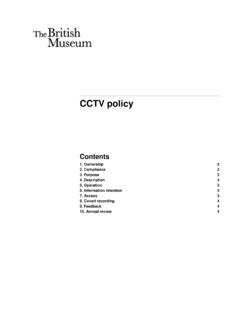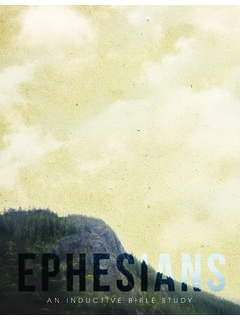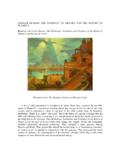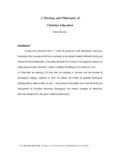Transcription of Ancient Greece: Myths and legends - British Museum
1 Ancient greece : Myths and legends Black-figured amphora Herakles and the Stymphalian birds Athens, greece around 540 BC Visit resource for teachers Ancient greece : Myths and legends Contents Before your visit Background information Resources Gallery information Preliminary activities During your visit Gallery activities: introduction for teachers Gallery activities: briefings for adult helpers Gallery activity: Labours of Herakles Gallery activity: Herakles Gallery activity: Theseus and his enemy Gallery activity: Odysseus and the Cyclops Gallery activity: Create your own monster After your visit Follow-up activities Ancient greece : Myths and legends Before your visit Ancient greece : Myths and legends Before your visit Background information Modern experts on Ancient greece no longer distinguish between Myths and legends as they have so many features in common - they prefer to think in terms of a whole set of mythical stories.
2 These mythical stories cluster around a number of focuses. Some of them involve just gods and goddesses and focus on the creation of the world and of humans and the rule of the gods; some deal with a specific hero such as Theseus or Herakles; some focus on a place, for example Thebes or Athens, or an event, for example the Trojan War. Myths had important purposes for the Ancient Greeks and formed a part of their belief system. Most Myths explain or justify things in some way, whether this is the creation of the world, the cycle of seasons, the role of women in society or the origins of a city. We should not assume that all Greeks believed them in a straightforward way or that there was a fixed version for every story.
3 Greek writers felt at liberty to make up their own versions of stories or to poke fun at mythical characters - especially Herakles. There is evidence from Greek pottery painting that there were several variants of a myth in circulation at any one time. Greek philosophers question the basis of Myths and also make up their own Myths to represent their own systems of thinking. The cast of characters in Myths includes gods (see the visit resource on gods and goddesses in this series) and heroes/heroines: this resource has activities focused on Herakles, the most famous of Greek heroes, who was especially associated with the part of greece called the Peloponnese, Theseus, the Athenian hero and Odysseus, the cleverest hero.
4 Places associated with heroes such as these often had shrines and held religious rituals in their honour. Another frequent type of character in Greek Myths is the monster or fantastic creature. These are often part-human and part-animal. As such they can represent the animal nature of humans as well as being experiments in imagining certain aspects of human nature carried to extremes or freed from the constraints of society. Ancient greece : Myths and legends Before your visit Resources British Museum websites Teaching history with 100 objects Free online resources to support teachers working in the new history curriculum through object-based learning.
5 Access information, images, and video as well as teaching ideas for lessons at Key Stages 1-3. Books For adults Burn, Lucilla, Greek Myths , British Musem Press, 1990 reprint 2006. For children Harris, John and Brown, Calef, Mythical Beasts of greece and Rome, British Museum Press, 2002. Woff, Richard, Pocket dictionary of Greek and Roman gods and goddesses, British Museum Press, 2003. Woff, Richard, Pocket dictionary of Heroes and Heroines of Ancient greece , British Museum Press, 2004. Ancient greece : Myths and legends Before your visit Gallery information Room 69 explores the daily life of both the Ancient Greeks and Romans.
6 The cases are displayed in themes covering the major aspects of everyday life. As some of the cases display both Greek and Roman objects encourage your students to read the labels in order to distinguish the Greek objects. The cases are numbered and their theme title is clearly displayed. Cases in the centre of the room concentrate on everyday life. Cases along one wall display crafts and along the other mythology. The mythology cases are located along the wall underneath the section of balcony cases. The case numbers are the same as other cases in the room, ensure the adult group leaders are aware which cases they should be is a small pool and fountain in one corner of the room.
7 What is it like to visit this gallery? Room 69 is a popular gallery with school groups and can become very crowded. The room has exits from either end. The north exit leads into a suite of galleries exploring the Ancient Greek and Roman worlds. The south-eastern exit leads into the Money Gallery. In the west wall there is a small display area off the gallery which contains changing exhibitions from the Coins and Medals Department. Case Numbers Please note that case numbers are usually small, white and high up on the glass. Ancient greece : Myths and legends Before your visit Preliminary activities General introductory activities Locate the area covered by Ancient greece in an atlas and look at the modern countries which currently exist in this region of the world.
8 Discuss Ancient greece in terms of culture, geography and climate. Activities to support gallery activities Look at examples of Greek Myths on pots. Explain how the depictions reveal the story they refer to without using words. Discuss some Ancient Greek Myths and their characters. Use examples to illustrate the challenges faced by a hero and the behaviour of the gods. Talk about how Greek Myths were told and passed from one person to another. Explain that they were not written down but instead repeated from memory. Ancient greece : Myths and legends During your visit Ancient greece : Myths and legends During your visit Gallery activities: introduction for teachers The gallery activities are a set of activity sheets which can be used by students working in Room 69.
9 The sheets can be used as stand-alone activities or you may wish to develop work around particular sheets as suggested in the before and after sections of this resource. Where case numbers are indicated on a sheet, these are usually to be found marked in white numbers high up on the glass of that particular case. You are welcome to select the activities which are most appropriate for the focus of your visit and adapt sheets to meet the needs of your students. Each activity is designed to support the students in looking at, and thinking about, objects on display in the gallery. Individual activity sheets may be undertaken by single students, in pairs or as a small group.
10 Where space is provided for recording this may be undertaken by the student or an adult helper as is most appropriate for the students involved. Familiarise the students and accompanying adults with the chosen activity sheets at school before the day of the visit. Make sure students and adults know what they are to do and are familiar with the vocabulary used on the sheets or which they may encounter in the gallery. Ancient greece : Myths and legends During your visit Gallery activities: briefings for adults Gallery activity: Labours of Herakles Herakles was forced to complete 12 Labours as punishment for killing his wife and children in a fit of madness.







